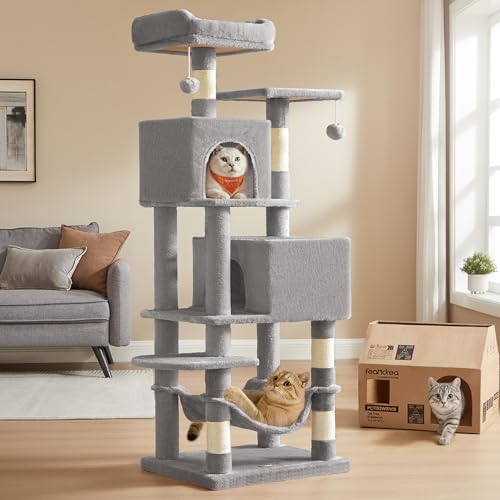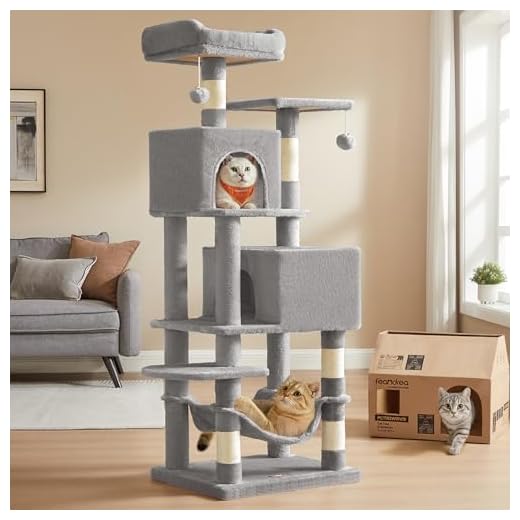



To minimize surprise pounces while you’re cozy, try using a soft toy as a distraction. Toss it around near the bed to redirect attention away from your limbs. This simple trick shifts focus and keeps those playful instincts engaged with something less vulnerable.
Creating a designated play area can also work wonders. Set up a space with various cat toys and climbing structures. This encourages playful energy to be channeled elsewhere, reducing the likelihood of surprise ambushes.
Incorporating regular play sessions into the daily routine can help, too. Use interactive toys like feather wands or laser pointers to provide physical and mental stimulation. Keeping busy with these activities can decrease the need for sneaky tactics under the covers.
Lastly, consider using a blanket that is less appealing for ambushes. A heavier fabric may discourage sudden strikes, while a lighter one allows for easier movement, making it less of a hiding place. Adjusting the environment can lead to more peaceful snuggle times.
Solutions for the Foot Ambush Problem
To address the playful ambush on hidden toes, consider incorporating interactive toys. Engaging with feather wands or laser pointers diverts attention from the blanket antics, allowing for constructive playtime. This redirection helps in channeling energy towards appropriate targets.
Creating a Cozy Retreat
Establish a designated space filled with soft bedding and enticing toys. This cozy area serves as an alternative haven, encouraging exploration rather than pouncing on concealed appendages. Regularly rotate toys to maintain interest and excitement.
Positive Reinforcement Techniques
Use treats or affection to reward calm behavior. When I choose to ignore the blanket, my human offers praise or a tasty snack. This approach strengthens the bond and promotes tranquility during lounging sessions.
Understanding Your Feline’s Hunting Instincts
Recognizing the natural predatory behaviors is key. I often stalk and pounce on anything that moves, including human appendages peeking from cozy coverings. This instinct is ingrained, stemming from my ancestors who relied on stealth and surprise to catch prey.
Playtime as a Substitute
Engaging in interactive play sessions can redirect this energy. Utilize toys that mimic prey, like feather wands or small balls, to satisfy the chase. Regularly scheduled play can help channel that instinct into appropriate activities, reducing focus on your moving limbs.
Nurturing a Calm Environment
Creating a serene atmosphere is beneficial. Provide cozy spots and adequate stimulation, including puzzle toys or scratching posts. A well-stimulated mind can lessen the urge to ambush unsuspecting feet. For older companions, consider the best cat food for older cats with bad teeth to support their health and keep them active.
Creating a Safe Space for Your Feline Friend
Establishing a cozy retreat enhances my well-being and reduces stress. Here are key steps for creating that perfect environment:
- Choose a Quiet Location: Select a corner of your home that is away from noise and high traffic. A secluded spot allows for relaxation and comfort.
- Provide Cozy Bedding: Soft blankets or cushions make a great resting area. Ensure it’s warm and inviting, as I love to curl up in plush spots.
- Add Hiding Spots: Incorporate boxes, tunnels, or cat caves where I can retreat for solitude. These spaces cater to my instinct to seek safety.
- Incorporate Vertical Spaces: Shelves or cat trees offer elevated areas for me to perch and observe my surroundings. This helps me feel secure and in control.
- Use Calming Scents: Products with feline-friendly pheromones can create a soothing atmosphere. Sprays or diffusers can aid in relaxation.
- Limit Distractions: Keep the area free from loud noises or interruptions. A tranquil environment promotes peace and comfort.
These adjustments not only help me feel secure but also discourage unwanted behaviors. A designated space fosters a sense of safety and tranquility, making for a happier and more relaxed companion.
Redirecting Attention with Toys
Invest in a variety of engaging toys that stimulate playfulness. Wand toys with feathers or strings are excellent for interactive sessions. They not only divert focus from my feet but also encourage exercise.
Consider toys that mimic prey, such as small balls or mice. These can be hidden around the house, enticing exploration and pouncing, satisfying natural instincts without targeting human limbs.
Rotate toys frequently to maintain interest. Introducing new items keeps the environment dynamic, preventing boredom. A simple cardboard box or paper bag can be transformed into an exciting play zone.
Establish a routine for playtime. Short, frequent sessions throughout the day help release pent-up energy. Each session can end with a treat, reinforcing positive behavior and creating a satisfying conclusion.
| Toy Type | Benefits |
|---|---|
| Wand Toys | Promote interaction and exercise; great for bonding. |
| Small Balls | Encourage chasing and batting; stimulate hunting instincts. |
| Interactive Puzzles | Challenge intellect; provide mental stimulation. |
| Cardboard Boxes | Encourage exploration; can be transformed into forts. |
Engaging play not only distracts from unwanted behaviors but also strengthens the bond between us, fostering a happier and more fulfilling environment. Regular interaction through toys enhances well-being and reduces stress.
Establishing Boundaries During Playtime
Setting clear limits during play is key to maintaining a harmonious environment. I suggest using a designated play area. This confines the action to one spot, helping to signal to my human when the fun begins and ends. It also minimizes distractions from other household activities.
Introduce specific toys meant for interactive sessions. These should be distinct from everyday items, like feet or blankets. When I engage with these toys, my human can reinforce the idea that playtime is for the appropriate objects only.
Consistent Signals
It’s beneficial for my human to establish consistent signals for playtime versus quiet time. A specific sound, like a whistle or clap, can indicate the start of play. When that sound is made, I know it’s my cue to engage with the toys instead of targeting anything else.
Positive Reinforcement
Rewarding me with treats or affection when I play with the right items reinforces good behavior. This encourages me to seek out the designated toys rather than my human’s toes. Consistency in this approach builds a clear understanding of acceptable playtime activities.
Using Positive Reinforcement Techniques
When my human sees me pouncing on hidden feet, they quickly grab a treat and reward me for playing with my favorite toy instead. This method helps me associate good behavior with tasty rewards. Every time I choose to engage with a toy, I get a yummy snack. It’s a fun way to learn!
Creating a consistent routine is also key. My human always has treats ready during playtime. This makes me eager to follow the rules because I know there’s a tasty surprise waiting for me. I can tell they’re pleased when I redirect my energy to a toy instead of those tempting toes.
Another trick is to use a clicker. Each time I play with a toy instead of attacking, my human clicks the clicker and gives me a treat. The sound becomes a signal that I’m doing something right. Over time, the clicker and the rewards help me understand what behavior is expected.
My human also encourages me with cheerful praise, which boosts my confidence. Hearing them say “good kitty” when I play appropriately makes me feel proud. This positive feedback motivates me to keep up the good work!
For those looking to clean up after playtime, check out the best petrol pressure washer for cleaning patios. Keeping the space tidy helps maintain a playful environment without distractions.
When to Consult a Veterinarian or Behaviorist
If my playful skirmishes escalate into aggressive behaviors, seeking professional advice is essential. Signs of stress or fear, such as hiding, excessive vocalization, or avoidance, warrant immediate attention. Persistent aggression may indicate underlying health issues or anxiety that needs addressing.
Recognizing Behavioral Changes
Any sudden shift in my typical demeanor–like increased irritability or withdrawal–could signal a need for intervention. If my playful antics turn into frequent biting or scratching, it’s time to consult a veterinarian or a behaviorist. They can offer insights into whether my conduct is normal or if there are deeper issues at play.
Health Concerns
Physical ailments can manifest as behavioral problems. If I show signs of pain, such as limping or sensitivity to touch, medical evaluation is crucial. A check-up can rule out conditions that might influence my actions. Regular health assessments can help maintain my well-being and address any concerns promptly.
In summary, when my playful nature crosses into discomfort or aggression, reaching out for professional guidance is a wise step. Understanding my physical and emotional health is key to ensuring harmony at home.










